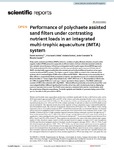Mostrar o rexistro simple do ítem
Performance of Polychaete Assisted Sand Filters Under Contrasting Nutrient Loads in an Integrated Multi-Trophic Aquaculture (IMTA) System
| dc.contributor.author | Jerónimo, Daniel | |
| dc.contributor.author | Lillebø, Ana Isabel | |
| dc.contributor.author | Santos, Andreia | |
| dc.contributor.author | Cremades, Javier | |
| dc.contributor.author | Calado, Ricardo | |
| dc.date.accessioned | 2021-04-07T09:29:53Z | |
| dc.date.available | 2021-04-07T09:29:53Z | |
| dc.date.issued | 2020-11-30 | |
| dc.identifier.citation | Jerónimo, D., Lillebø, A.I., Santos, A. et al. Performance of polychaete assisted sand filters under contrasting nutrient loads in an integrated multi-trophic aquaculture (IMTA) system. Sci Rep 10, 20871 (2020). https://doi.org/10.1038/s41598-020-77764-x | es_ES |
| dc.identifier.issn | 2045-2322 | |
| dc.identifier.uri | http://hdl.handle.net/2183/27673 | |
| dc.description.abstract | [Abstract] Polychaete assisted sand filters (PASFs) allow to combine a highly efficient retention of particulate organic matter (POM) present in aquaculture effluent water and turn otherwise wasted nutrients into valuable worm biomass, following an integrated multi-trophic aquaculture (IMTA) approach. This study evaluated the bioremediation and biomass production performances of three sets of PASFs stocked with ragworms (Hediste diversicolor) placed in three different locations of an open marine land-based IMTA system. The higher organic matter (OM) recorded in the substrate of the systems which received higher POM content (Raw and Df PASFs – filtered raw and screened by drum filter effluent, respectively) likely prompted a superior reproductive success of stocked polychaetes (final densities 2–7 times higher than initial stock; ≈1000–3000 ind. m−2). Bioremediation efficiencies of ≈70% of supplied POM (≈1.5–1.8 mg L−1) were reported in these systems. The PASFs with lower content of OM in the substrate (Df + Alg PASFs – filtered effluent previously screened by drum filter and macroalgae biofilter) differed significantly from the other two, with stocked polychaetes displaying a poorer reproductive success. The PASFs were naturally colonized with marine invertebrates, with the polychaetes Diopatra neapolitana, Terebella lapidaria and Sabella cf. pavonina being some of the species identified with potential for IMTA. | es_ES |
| dc.description.sponsorship | European Commission; Centro-01-0145-FEDER-000018 | es_ES |
| dc.description.sponsorship | European Commission; MAR-02.01.01-FEAMP-0038 | es_ES |
| dc.description.sponsorship | Fundação para a Ciência e a Tecnologia (Portugal); PD/BD/127989/2016 | es_ES |
| dc.description.sponsorship | Fundação para a Ciência e a Tecnologia (Portugal); UIDB/50017/2020+UIDP/50017/2020 | es_ES |
| dc.language.iso | eng | es_ES |
| dc.publisher | Springer Nature | es_ES |
| dc.relation.uri | https://doi.org/10.1038/s41598-020-77764-x | es_ES |
| dc.rights | Atribución 4.0 Internacional | es_ES |
| dc.rights.uri | http://creativecommons.org/licenses/by/4.0/ | * |
| dc.subject | Marine biology | |
| dc.subject | Sustainability | |
| dc.title | Performance of Polychaete Assisted Sand Filters Under Contrasting Nutrient Loads in an Integrated Multi-Trophic Aquaculture (IMTA) System | es_ES |
| dc.type | info:eu-repo/semantics/article | es_ES |
| dc.rights.access | info:eu-repo/semantics/openAccess | es_ES |
| UDC.journalTitle | Scientific Reports | es_ES |
| UDC.volume | 10 | es_ES |
| UDC.startPage | 20871 | es_ES |






